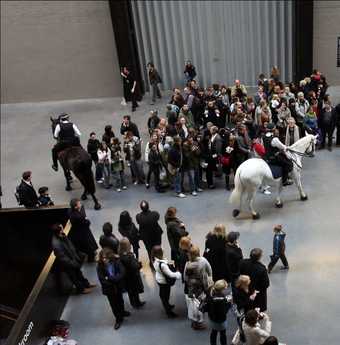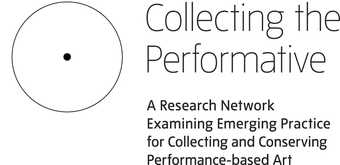The text was jointly authored by the participants in the final meeting of the research network Collecting the Performative, which examined emerging models for the conservation and documentation of artists’ performance and drew upon the practices of dance, theatre and activism in order to identify parallels in the concept of a work and related notions of authorship, authenticity, autonomy, documentation, memory, continuity and liveness.
By bringing together Dutch and British academic scholars and museum professionals, the project aimed to provide greater insight into the conceptual and practical challenges related to collecting and conserving artists’ performance.
1. Agree and understand the basic parameters of the work:
- Ask the artist to provide a description of the work for someone who has never seen it before.
- What are the basic parameters of the work; duration, space, number and nature of performers, variability?
- Does the work exist in more than one form? If so, what are the different form the work takes? For example a live element and an archive etc.
- Is it within the ‘DNA’ of the work that it evolves or emerges over time? Is repetition an important structural component of the work?
- Does the work reference any specific performance context? For example, dance, theatre, activism, contemporary music, expanded cinema? How does this impact the way that the work is understood now and in relation to how much can the work change and still be the same work?
- Is the work dependent on a moment in time (political, cultural, social)? If so how will this be managed in the future form of the work?
- Is the work dependent on a particular person?
- Is the work dependent on a particular place or architectural setting?
- Where are the biggest challenges in activating this work now and in the future?
Health and safety concerns; Cost (For example in a work which requires hiring people for an extended period of time, the cost of showing the work can be high); Level of institutional commitment involved; Skills (Many live works involve people who are hired or recruited as volunteers to conduct the performance. A work may require particular skills from those undertaking the performance. These may be professional skills for example the policemen and horses who are trained to use horses in crowd control (Tania Bruguera ‘Tatlin’s Whisper #5’ 2008), yoga instructors (Jennifer Allora & Guillermo Calzadilla ‘Balance of Power’ 2007, or amateur singers (Tino Sehgal ‘This is propaganda’ 2002). It is also the case that the skills involved in rehearsing, auditioning and producing these works are specific and may not be common in the museum. In some cases specialised transmitters or producers are employed by the artist, these have specific and constant engagement with the realisation of a particular group of works. This points to a more distributed model whereby in order to maintain the ability to display a work the museum needs to maintain connections with those with the specific knowledge as transmitters or with specific skilled groups. The rhythm of the museum means that works often do not get shown for many years once collected, it is therefore possible to maintain these skills within the museum? Many of these works are sold as editions and hence the artist may have people who work constantly on the realisation of a body of their works. Specific space required and also perhaps the different use of spaces within the museum.
2. Relationship with the museum /collection
- What are the key points that need to be negotiated with the museum in relation to the acquisition or performance (eg. the extent of artist involvement)
- Does this work challenge or critique the museum? If so how?
- How does the work use or depend on the museum and the museum staff?
- Who needs to be involved in the work: Both roles (conservator, curator, producer, artist) and skills (technical staff/licences)
- At what stage do they need to be involved? (At the acquisition stage/production stage)
- Is the work site specific to a particular area of the museum, is it meant to be/ can it be shown outside the museum?
- What resources will be required now and in the future? Consider financial resource and also time, space, capability, knowledge and technology
- What other parties are also need to be in this relationship? For example performers, external specialists
- What are the relative freedoms of each party in the agreement? For example to make changes to the work
- What is the role of the museum audience ( participation)
- What is the work’s relationship with other works in the museum’s collections? Does it reference them or use them. Is it part of a sequence of works?
- Do you expect extreme reactions to the work? Is it allowed that staff intervene if so how?
- What makes a successful performance of this work?
- What are the conditions of the space? Does the space where the work is performed need to be modified in any way?
- What is the duration of the work, what are its hours, if it is open when the gallery is open, how are special events dealt with?
- Is any special lighting required?
- Is any special acoustics required?
- Is the museum required to produce anything for each performance (see a. Props below)?
- How much does it cost to install the work?
- Are there any Health and safety or legal issues in performing the work?
- Are permissions or licenses needed from any external body?
- Is the work rehearsed? What does this mean?
- What maintenance and monitoring is required whilst on display?
3. The production of the performance
a. Props
- Are there any props?
- If so what are their status? Is this likely to change over time? Does registration need to be involved?
- Are the props consumed or destroyed during the performance?
- Do these objects form part of the art work?
- Do these objects form part of an ‘archive’?
b. Hiring / auditioning
- Do we need to hire interpreters/performers?
- How do we advertise the role?
- Is there an auditioning process?
- What does the HR department need to take care of? Shifts? Pay? Rules for dealing with illness, absence?
c. Roles
- Who is responsible for the different aspects of the work; for example its production, display, documentation and conservation?
- What are the requirements for internal communication about the work, for example are there any restrictions related to Front of house, photography etc
- What aspects are considered a shared responsibility?
4. Documentation
- What forms of documentation are available?
- What needs to be documented and for what purpose?
- Is there an artist interview? If so who conducted it and what does it cover?
- What types of agreement need to be documented? For example, licence agreements, acquisitions agreement, ownership agreement, copyright agreement etc.
- What categories of documentation are present and needed for this work. For example, instructions, artist statement, archival documentation of previous performances, audience experience
- How should the performance itself be documented?
- How should the work be publicly expressed when not being performed? For example, through moving image, still photography, artist statement? Should audio be included? Are there any restrictions?
- How often should the documentation be reviewed?
- How is the documentation used in the reactivation of the work?
- Is there value in producing a testimony of the performance each time it is performed? For example, from each performer, as a critique or evaluation from the artist, as a review of the performance
- Can the documentation be shared - for example can the working documents be digitised and made broadly available?
- Who owns the rights?
- What is the status of the documentation? Might it represent the work’s legacy? Can it be shown with the work in future?
5. Audience
- What type of interpretation is required for this work?
- How does the audience encounter the work?
- Are the audience participants in the work? If so how?

Tania Bruguera
Tatlin’s Whisper #5 (2008)
Tate
Acknowledgments
This document was jointly authored from the final network meeting held at the Cultural Heritage Agency of the Netherlands in Amsterdam on 24 January 2014.
The meeting participants and authors of The Live Listare Christiane Berndes, Curator & Head of Collections, Van Abbemuseum; Hendrik Folkerts, Curator Public Programs, Stedelijk Museum in Amsterdam; Diana Franssen, Curator & Head of Research, Van Abbemuseum; Adrian Glew, Archivist, Tate; Panda de Haan, independent researcher; Ysbrand Hummelen, Senior Research Conservator, Cultural Heritage Agency of the Netherlands; Pip Laurenson, Head of Collection Care Research, Tate (Principle Investigator); Andrea Lissoni, Curator of Film and International Art, Tate; Isabella Maidment, PhD Candidate, Tate; Angela Matyssek, Research Fellow, Faculty of Arts and Social Sciences, Maastricht University; Kate Parsons, Head of Collection Management, Tate; Capucine Perrot, Assistant Curator, Tate Modern; Vivian van Saaze, Faculty of Arts and Social Sciences, Maastricht University (Co-Investigator); Tatja Scholte, Senior Researcher, Cultural Heritage Agency of the Netherlands; Patricia Smithen, Head of Conservation (Programme), Tate; Sanneke Stigter, Coordinator and Lecturer for Contemporary Art Conservation, University of Amsterdam; Paulien ‘t Hoen, Coordinator, Foundation for the Conservation of Contemporary, Art (SBMK); Renée van de Vall, Professor of Arts and Media, Faculty of Arts and Social Sciences, Maastricht University; Gaby Wijers, Director, LIMA.
How to cite: Pip Laurenson, Christiane Berndes, Hendrik Folkerts, Diana Franssen, Adrian Glew, Panda de Haan, Ysbrand Hummelen, Andrea Lissoni, Isabella Maidment, Angela Matyssek, Kate Parsons, Capucine Perrot, Vivian van Saaze, Tatja Scholte, Patricia Smithen, Sanneke Stigter, Paulien ‘t Hoen, Renée van de Vall and Gaby Wijers, ‘The Live List: What to Consider When Collecting Live Works’, Collecting the Performative Network, 24 January 2014.

Supported by the Arts and Humanities Research Council and the Netherlands Organisation for Scientific Research 2012–2013


